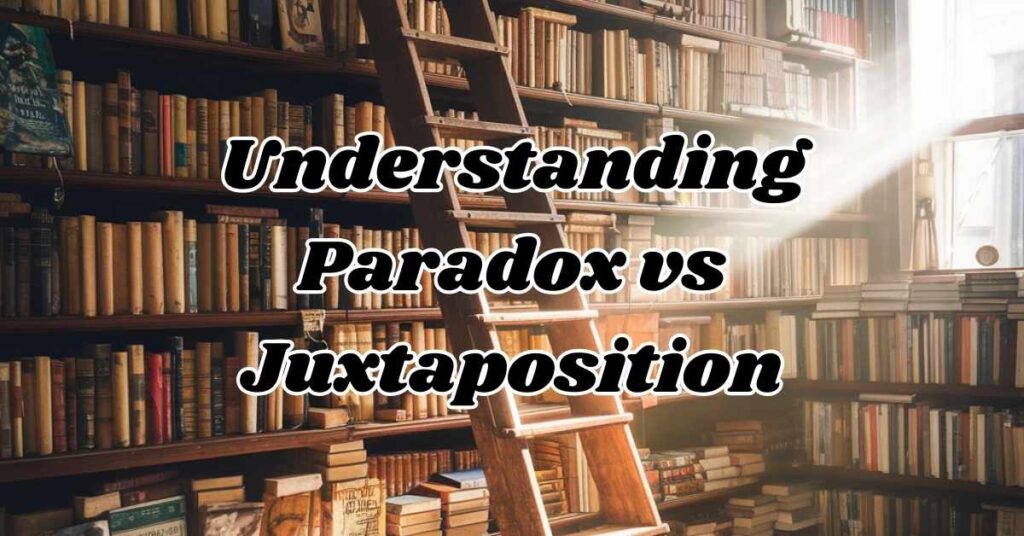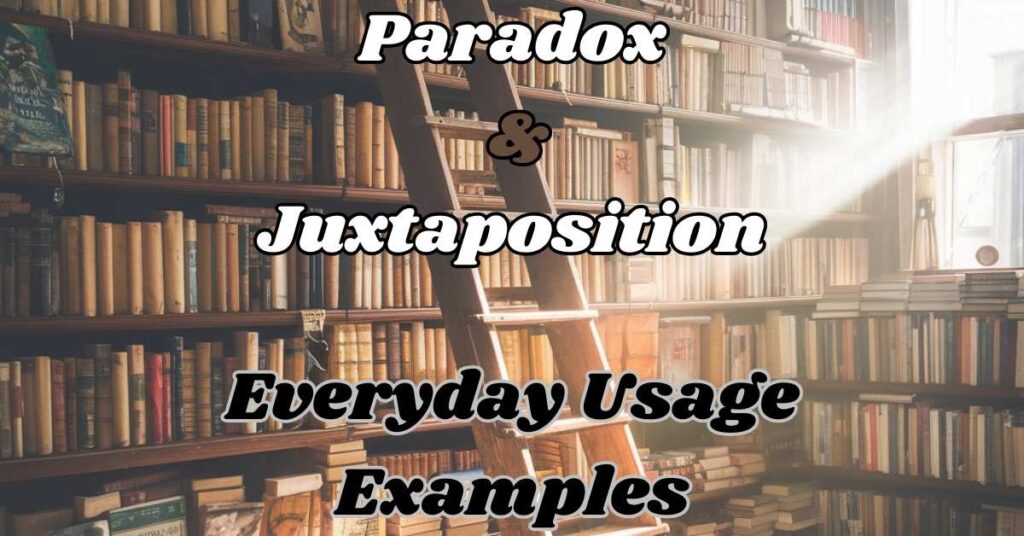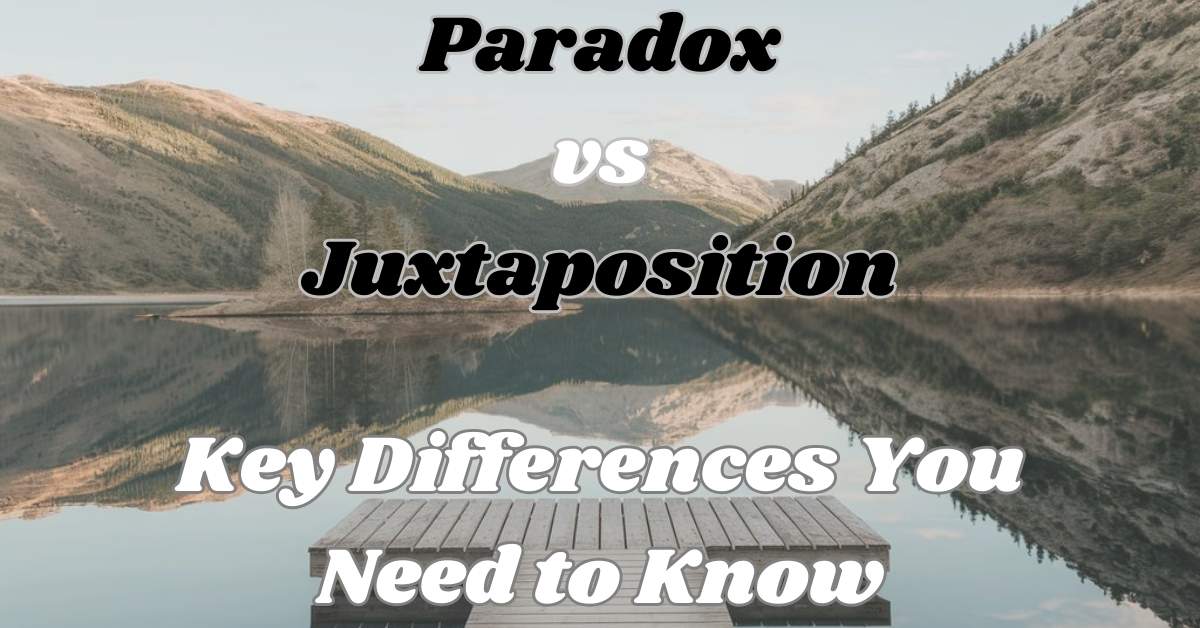Paradox vs Juxtaposition are two powerful literary devices that make stories and art more engaging. Both involve contrasts but work in different ways. A paradox shows a statement or idea that seems illogical but reveals a hidden truth, like “less is more.”
On the other hand, juxtaposition places contrasting elements side by side to highlight their differences, creating vivid contrasting imagery. These tools bring depth and emotion to storytelling, helping writers and artists connect with their audience.
Understanding the difference between paradox and juxtaposition can improve how we interpret and create meaningful works. Let’s dive deeper into their unique roles and why they matter.
Quick Summary
A paradox refers to a statement or circumstance that appears to be self-contradictory, yet frequently uncovers a more profound truth.. For instance, the phrase “less is more” might seem impossible at first, but it highlights how simplicity can be powerful.
Juxtaposition, on the other hand, involves placing two contrasting elements side by side to highlight their differences. Both techniques are used to emphasize contradictory ideas or provide a visual contrast, but they are not the same.
While both can make a statement more powerful or interesting, understanding their differences allows us to use them more effectively in our writing and creative work.
Understanding Paradox vs Juxtaposition

At their core, paradox and juxtaposition are about contrast, but they differ in how they are used. A paradox creates a contradiction in literature by showing how seemingly opposing ideas can exist together, offering deeper insights into a subject.
It often challenges our logical reasoning and encourages us to think more deeply. For example, in George Orwell’s 1984, the slogan “War is peace” is a paradoxical statement that forces readers to reconsider the relationship between peace and war in the dystopian world.
On the other hand, juxtaposition is a literary device used to place two contrasting ideas, images, or themes side by side. This contrasting imagery allows the differences between them to stand out.
It’s commonly used in literary analysis of paradox when comparing two opposite characters, settings, or ideas to highlight their differences or similarities.
For example, in Charles Dickens’ A Tale of Two Cities, the opening line “It was the best of times, it was the worst of times” uses juxtaposition to present contrasting conditions in society.
Origins of Paradox
The word “paradox” comes from the Greek word paradoxos, meaning “contrary to expectation,” derived from para- (beyond) and dokein (to think). It was later adopted into Latin as paradoxum and entered English in the 1500s.
Philosophers like Socrates and Heraclitus used paradoxes to illustrate that truth often lies in apparent contradictions. The first known use of the word in English was in 1533 by Thomas More.
Over time, paradox became a literary technique, conveying complex ideas and challenging established beliefs. Paradoxes often express truths about human nature or society, prompting deep reflection.
Origins of Juxtaposition
Juxtaposition, derived from the Latin word juxtapositus, meaning “next to,” was first used in English in 1661 by Joseph Glanvill.
The technique has been widely used in art and literature since the Renaissance, placing contrasting ideas or images together to provoke thought. In visual art, juxtaposition often contrasts light and dark or old and new to create a visual impact.
In modern storytelling, it highlights differences in characters, settings, or emotions, such as the wealthy vs. the poor or the innocent vs. the guilty, to explore themes of conflict and societal contradictions. The word “juxtapose” emerged in the 19th century.
Paradox: Definition and Usage

A paradox is often used to express ideas that seem contradictory at first but reveal a deeper, sometimes hidden, truth.
In literature, paradox examples are used to show the complexities of human existence or the absurdity of certain social or philosophical beliefs. These coexisting contradictions force the reader to think critically about the meaning behind the words.
For example, in Shakespeare’s Hamlet, the famous line “To be, or not to be, that is the question” is a paradox.
The question seems contradictory, as it asks whether one should exist or not, but it reflects Hamlet’s internal struggle with the meaning of life and death. This paradox pushes the audience to explore deeper philosophical questions about life’s purpose.
Synonyms for Paradox
Here are synonyms for paradox that may be used in different contexts:
- Contradiction
- Anomaly
- Irony
- Absurdity
- Enigma
- Opposition
- Paradoxical situation
- Incongruity
- Dilemma
- Riddle
Each of these words captures a slightly different nuance of contradictory ideas, but all represent a scenario where logic or expectation is defied.
Juxtaposition: Definition and Usage

In contrast to paradox, juxtaposition doesn’t always involve contradiction. Instead, it’s about comparing two contrasting elements side by side to highlight their differences.
In literature, juxtaposition examples can show the stark contrasts between two characters or settings. For instance, comparing a poor character’s life with a wealthy one can highlight themes of inequality and social justice.
In visual arts, juxtaposition is often used to create a visual contrast between light and shadow, old and new, or different emotions.
The contrast brings focus to each element, making the work more engaging. A famous example in modern art is how abstract and realistic elements are often placed together, making the viewer think about their relationships.
Synonyms for Juxtaposition
Here are synonyms for juxtaposition:
- Contrast
- Comparison
- Opposition
- Conjunction
- Adjoining
- Side-by-side
- Collocation
- Proximity
- Neighboring
- Parallelism
Each synonym can be used to describe the placement of two elements together, with slight variations in meaning depending on the context.
Side-by-Side Comparison
| Aspect | Paradox | Juxtaposition |
| Definition | A self-contradictory statement that reveals a truth. | The placement of two contrasting elements side by side. |
| Usage | Used to challenge logic or expectations. | Used to highlight contrasts or similarities between two things. |
| Example | “Less is more” | The contrast between a rich man and a poor man in a story. |
| Effect | Provokes deep thought and reflection. | Creates visual or emotional contrast. |
Everyday Usage Examples

In daily life, paradox and juxtaposition can be seen everywhere. A paradoxical statement might appear in a conversation, like saying “the more you know, the less you understand.” This makes people stop and think.
On the other hand, juxtaposition is often found in advertisements, where a product is placed next to something undesirable to highlight its value.
Juxtaposition is also seen in films. Imagine a film scene where a peaceful, beautiful landscape is suddenly interrupted by an aggressive storm.
The contrast emphasizes the storm’s power. Similarly, the paradox can appear in movies, like in The Matrix, where the idea that reality isn’t real challenges viewers’ understanding of truth.
Paradox
Paradox plays a crucial role in literature and philosophy. It is often used to express deep, thought-provoking paradoxes that engage the reader’s mind.
Famous examples include the works of existential philosophers like Albert Camus, who examined the meaning of life through paradoxical situations.
In fiction, paradox reveals complex ideas about the human condition, contradiction in literature, and the unpredictable nature of life.
Juxtaposition
In literature and art, juxtaposition is a powerful tool used to create emotional contrast. By placing two opposing elements together, writers and artists can evoke strong feelings in the audience.
A famous example is the contrasting imagery found in the works of William Blake, who used the idea of innocence vs. experience to explore human nature.
Similarly, in visual contrast, artists use juxtaposition to make their work stand out, guiding the viewer’s emotional response to the art.
Context Matters
The context of your writing or art determines whether to use paradox or juxtaposition. In comparative analysis, knowing when to employ each device can enhance the impact of your message.
If you’re aiming to challenge logic or reveal deeper truths, paradox is likely the better choice. But if you want to highlight contrasts or create an emotional response, juxtaposition is the way to go.
Paradox
Use paradox when you want to make the audience think deeply or question assumptions. It’s particularly useful in philosophical writing or when exploring complex themes like symbolism in literature or contradictory ideas.
Juxtaposition
Juxtaposition is best for when you want to show clear contrasting ideas in writing or illustrate differences in a way that adds depth to your story. It’s often used in visual impact in storytelling and comparative literary elements.
Common Mistakes to Avoid

A common mistake is using paradox and juxtaposition in literature incorrectly, assuming they are interchangeable.
Paradox requires contradictory ideas that exist together, while juxtaposition is simply placing elements side by side to highlight differences. Mixing these concepts up can confuse the audience.
Tips for Avoiding These Mistakes
When working with paradox or juxtaposition, always consider the purpose. If you’re aiming for a thought experiment paradox, focus on creating an idea that challenges understanding. If you want to highlight differences, juxtaposition in art or literature is your tool.
Conclusion
Understanding the difference between Paradox vs Juxtaposition is crucial for deeper appreciation and analysis of literary techniques.
While a paradox challenges our expectations by revealing hidden truths through contradictory ideas, juxtaposition highlights contrasts by placing elements side by side, emphasizing their differences.
Both are powerful tools for creating tension, adding depth, and provoking thought in storytelling. By recognizing how and when to use these rhetorical devices, writers and artists can craft more impactful words that resonate with their audiences on multiple levels.
Read More Article: Foremen or Foreman: What’s the Difference
FAQS: paradox vs juxtaposition
What’s the difference between a paradox and juxtaposition?
A paradox is a contradictory statement that reveals a truth, while juxtaposition is the placement of contrasting ideas side by side for effect.
Is an oxymoron a paradox?
An oxymoron is a type of paradox that combines contradictory terms, like “bittersweet,” into a single expression.
What is paradox in simple words?
A paradox is a statement that seems impossible or contradictory but holds a hidden truth.
What is a good sentence for juxtaposition?
“The painting’s dark shadows and vibrant highlights create a striking juxtaposition.”
What is the rule of juxtaposition?
Juxtaposition involves placing contrasting ideas, images, or elements together to highlight their differences and create an impactful comparison.

